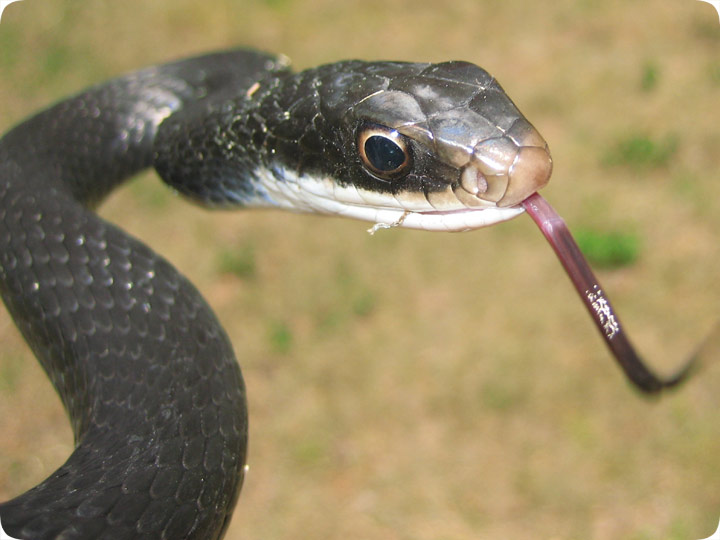-
info@aaanimalcontrol.com
Call us for help in your town
Humane Wildlife Education
Florida Black Racer

04.29.2006 - Ah, the Southern Black Racer, (Coluber constrictor priapus), the most common snake that I deal with here in Orlando Florida. I estimate that about 40% of all snake calls that I get are due to this one species of snake alone. They are simply
very capable snakes, good at surviving, and they can adapt to a wide variety of habitats. Whereas other snakes inhabit more specific ecological niches, or simply need just the
right protection, Black Racers do fine in a variety of habitats, including suburban and urban. One often has to travel outside of developed Orlando to find the rarer
snakes, but the Black Racer lives even in downtown. Plus, it's very active and is a daytime snake, so one can understand, why out of the 30 or so species that I've
caught, this one dominates in numbers.
This snake is strong and fast! It's an excellent climber. Thus, it's often difficult to capture. With most
species of snake, if I see it, I get it in the bag. Not always so with the Black Racer. At first, I missed many of them. Now that I'm more of a seasoned pro I
get nearly all of them, but if I arrive and this snake is lying on a thick hedge or other heavy vegetation, there's a chance I won't get it. They have excellent vision,
and if my first approach isn't just right, and my first strike perfect, off it goes, and it could be gone. It can kind of dart, in any direction, lickety split.
Half of the time I grab this snake by hand and then ward off the bites, but much of the time I "pin" the snake down with my snake hook. I do not injure it, but pinning is
a higher percentage catch than an attempt to grab with tongs or pick up with a hook, as both moves require perfect precision.
Black Racers are constrictors, and they eat
almost anything they can catch and swallow. The snake in the above photo has caught a piece of lint in its mouth. They are black with gray bellies and a white chin.
The grow a little above five feet, and most of the ones I catch are in the 3-4 foot range. It pretty much goes May mating, June eggs, September hatching.
Do it yourself: Visit my How To Get Rid of Snakes page for tips and advice.
Get professional help: Visit my Nationwide Pro Directory of wildlife removal experts.
For more wildlife stories, click my Wildlife Blog
or click my below banner to hire a local trapper.
You can also catch snakes with a special trap, which you can order by clicking this banner:

Finding a snake in your property or your yard may be alarming. However, not all snakes are out to try and poison you or hurt you. Take the Florida black racer for example. This is a common specie that is non-venomous and often found in the southeast of the United States, especially in Florida.
Appearance
The black racer, as its name suggests, is mainly the color black. They also have a black dorsal side, a gray belly, and a white chin. In some situations, their white chins may be the cause of their deaths as this feature is what causes some to assume that they are the water moccasin or cottonmouth snake, which is considered to be extremely dangerous. On the other hand, juvenile racers are blotched in the colors of gray to reddish browns.
The average size of adult black racers ranges from 20 to 55 inches long. Juvenile racers are much smaller than this. The longest black racer discovered reached up to 72 inches in length.
Diet
Snakes very commonly prey on smaller reptiles, rodents, and mammals. This is the same for the Florida black racer. Frogs, lizards, rodents, and other smaller animals are a part of their usual diets. They often prey on them mainly because they can easily overpower them through suffocation or by crushing them to the ground.
Although they seem like tough snakes, they aren't strong enough to go against their natural predators –which are dogs, cats, bigger birds, and more.
Behavior
A key trait with black racer snakes is their mobility since they are fast-moving. This is suggested in their name wherein the word “racer” is used. Their speed allows them to easily escape from predators and other threatening situations. To add, this ability is applied not only on land but when climbing and swimming as well.
They can slither at a speed of four miles per hour which is approximately the same as a human who is walking briskly. When they are threatened or trying to escape, they will use this to hide in bushes, grass, or tree branches.
Often, these snakes will choose to find a route away from the threat rather than face it head-on. However, in the event that they are cornered, they won't hesitate to fight back –usually applying extreme force to their bites and doing this repeatedly. They also sometimes charge at the threat if they are frightened.
More on the Florida Black Racer
With being present in areas with natural enemies, the black racer has been considered an endangered species. They are now mostly found in a small patches of the state, and could potentially disappear entirely if their homes are continuously being destroyed by both natural and manmade causes.
At times, they are harmed by man because they are killed either intentionally due to the threat they impose on humans or accidentally such as on highways. Although, not many are aware that they are rather harmless if they aren't provoked or threatened.




















